A Comparative Study of China’s Carbon Neutrality Policy and International Research Keywords under the Background of Decarbonization Plans in China
Abstract
:1. Introduction
2. Knowledge Map Visual Analysis of China’s Carbon Neutrality International Research
2.1. The Stage Division, Major Cooperative Countries, Major Discipline Classifications, and Major Research Organizations of China’s Carbon Neutrality International Research Achievements
2.2. The Keywords and Hotspots Evolution of China’s Carbon Neutrality International Research Achievements
3. Quantitative Analysis of National Policy Documents of Carbon Neutrality in China
3.1. The Time Series Evolution of National Policies and Initiatives of Carbon Neutrality in China
3.2. The Quantitative Analysis of National Policies of Carbon Neutrality in China and the Comparative Analysis of Policy and Research Keywords
4. Discussion
5. Conclusions
Author Contributions
Funding
Institutional Review Board Statement
Informed Consent Statement
Data Availability Statement
Acknowledgments
Conflicts of Interest
References
- IPCC. Special Report: Global Warming of 1.5 °C. 2018. Available online: https://www.ipcc.ch/sr15/ (accessed on 10 November 2018).
- Parmesan, C.; Yohe, G. A globally coherent fingerprint of climate change impacts across natural systems. Nature 2003, 421, 37–42. [Google Scholar] [CrossRef] [PubMed]
- Liu, Z.; Guan, D.; Moore, S.; Henry, L.; Su, J.; Zhang, Q. Climate policy: Steps to China’s carbon peak. Nature 2015, 522, 279–281. [Google Scholar] [CrossRef] [PubMed]
- Tan, X.; Guo, W.; Fan, J.; Guo, J.; Wang, M.; Zeng, A.; Su, L.; Sun, Y. Policy Framework and Technology Innovation Policy of Carbon Peak and Carbon Neutrality. Bull. Chin. Acad. Sci. 2022, 37, 435–443. [Google Scholar]
- Dong, L. International Climate Governance and China’s Policy Selection under Carbon Neutrality. Foreign Aff. Rev. 2021, 38, 132–154. [Google Scholar]
- CEADs. CEADs Study: Impacts of COVID-19 and Fiscal Stimuli on Global Emissions and the Paris Agreement. 2020. Available online: https://mp.weixin.qq.com/s/QWvHOh8498LchvCcvV6g3g (accessed on 23 December 2020).
- Shan, Y.; Ou, J.; Wang, D.; Zeng, Z.; Zhang, S.; Guan, D.; Hubacek, K. Impacts of COVID-19 and fiscal stimuli on global emissions and the Paris Agreement. Nat. Clim. Chang. 2021, 11, 200–206. [Google Scholar] [CrossRef]
- Science Facts. The COVID-19 Epidemic Has Caused a “Historic Decline” in Global Carbon Emissions? Don’t Be Too Happy. 2020. Available online: https://mp.weixin.qq.com/s/1SUqaEcfU_u1T9ZGLbSrtw (accessed on 1 July 2020).
- Liang, D.; Shi, L.; Zhao, J.; Liu, P.; Sarnat, J.A.; Gao, S.; Schwartz, J.; Liu, Y.; Ebelt, S.T.; Scovronick, N.; et al. Urban air pollution may enhance COVID-19 case-fatality and mortality rates in the United States. Innovation 2020, 1, 100047. [Google Scholar]
- CDM Fund. COVID-19 Crisis Means that We May Have Reached the Peak of Carbon Emissions. 2020. Available online: https://mp.weixin.qq.com/s/D5b_i9AjfLKRVtlnErj1FA (accessed on 23 April 2020).
- Tanjiaoyi. With the Decline of Global Carbon Emissions, Can the COVID-19 Crisis Bring about Green Recovery? 2020. Available online: https://mp.weixin.qq.com/s/GW0o04f0k07zL7dSAJyUSA (accessed on 8 May 2020).
- Goldman Sachs Research. Carbonomics: China Net Zero—The Clean Tech Revolution. 2021. Available online: https://www.goldmansachs.com/insights/pages/carbonomics-china-net-zero.html (accessed on 22 January 2021).
- Yang, C.; Hao, Y.; Irfan, M. Energy consumption structural adjustment and carbon neutrality in the post-COVID-19 era. Struct. Chang. Econ. D. 2021, 59, 442–453. [Google Scholar] [CrossRef]
- Zeng, Q.; Ma, F.; Lu, X.; Xu, W. Policy uncertainty and carbon neutrality: Evidence from China. Financ. Res. Lett. 2022, 47, 102771. [Google Scholar] [CrossRef]
- Wang, Q.; Zhang, M.; Jiang, X.T.; Li, R. Does the COVID-19 pandemic derail US-China collaboration on carbon neutrality research? A survey. Energy Strategy Rev. 2022, 43, 100937. [Google Scholar] [CrossRef]
- Wang, C.; Zhang, Y. Implementation Pathway and Policy System of Carbon Neutrality Vision. Chin. J. Environ. Manag. 2020, 12, 58–64. [Google Scholar] [CrossRef]
- Wang, W.; Liu, J. China’s Policy and Promotion in the New Era of Carbon Neutrality—China’s Development under Global Carbon Neutrality (I). Fin. Market Res. 2021, 108, 1–14. [Google Scholar]
- Liu, M. The Significance, Foundation, Challenges and Policy Focus of Realizing the Goal of “Carbon Neutralization” in China. Price Theory Pract. 2021, 2, 8–13. [Google Scholar]
- Chao, Q. The Scientific Connotation of “Carbon Peak and Carbon Neutrality” and China’s Policies and Measures. Environ. Sustain. Dev. 2021, 46, 14–19. [Google Scholar]
- Yuan, Z. Carbon Peak and Carbon Neutrality: National Strategic Action Roadmap; China Economic Press: Beijing, China, 2021; pp. 3–20. [Google Scholar]
- Yang, Y.; Chen, L.; Xue, L. Towards Carbon Peak and Carbon Neutralization: Goals, Paths and Actions; Shanghai Renmin Press: Shanghai, China, 2021; pp. 16–41. [Google Scholar]
- In-En.com. What Is Peak Carbon Dioxide Emissions and Carbon Neutrality. 2021. Available online: https://huanbao.in-en.com/html/huanbao-2376379.shtml (accessed on 18 August 2023).
- Climate Action Tracker. China Going Carbon Neutral before 2060 Would Lower Warming Projections by Around 0.2 to 0.3 Degrees. Available online: https://climateactiontracker.org/press/china-carbon-neutral-before-2060-would-lower-warming-projections-by-around-2-to-3-tenths-of-a-degree/ (accessed on 23 September 2020).
- Wallach, O. Race to Net Zero: Carbon Neutral Goals by Country. 2021. Available online: https://www.visualcapitalist.com/sp/race-to-net-zero-carbon-neutral-goals-by-country/ (accessed on 8 June 2021).
- Sustainable Development Strategy Research Group, Chinese Academy of Sciences. China Sustainable Development Report 2020: Exploring Pathway Towards Carbon Neutrality; Science Press: Beijing, China, 2021; pp. 1–12. [Google Scholar]
- Central Committee of CPC, State Council of China. Opinions of the Central Committee of CPC and the State Council of China on Completely, Accurately and Comprehensively Implementing the New Development Concept and Doing a Good Job of Carbon Peak and Carbon Neutrality. 2021. Available online: http://www.gov.cn/zhengce/2021-10/24/content_5644613.htm (accessed on 24 October 2021).
- State Council of PRC. Carbon Peak Action Plan by 2030. 2021. Available online: http://www.gov.cn/zhengce/content/2021-10/26/content_5644984.htm (accessed on 26 October 2021).
- Ministry of Science and Technology; National Development and Reform Commission; Ministry of Industry and Information Technology; Ministry of Ecology and Environment; Ministry of Housing and Urban-Rural Development; Ministry of Transport; Chinese Academy of Sciences; Chinese Academy of Engineering; National Energy Administration. Implementation Plan for Supporting Carbon Peak and Carbon Neutralization by Science and Technology (2022–2030). 2022. Available online: http://www.gov.cn/zhengce/zhengceku/2022-08/18/5705865/files/94318119b8464e2583a3d4284df9c855.pdf (accessed on 24 June 2022).
- Xinhua News Agency. Xi Jinping: Hold High the Great Banner of Socialism with Chinese Characteristics and Strive in Unity to Build a Modern Socialist Country in All Respects—Report to the 20th National Congress of the CPC. 2022. Available online: http://www.gov.cn/xinwen/2022-10/25/content_5721685.htm (accessed on 25 October 2022).
- Eleanor, Y. China’s Carbon Peak Carbon Neutrality “1+N” Policy System. 2022. Available online: https://zhuanlan.zhihu.com/p/514415703 (accessed on 17 May 2021).
- Jia, K. Goals on the road: Institutional innovations in carbon peak and carbon neutrality. J. Chin. Econ. Bus. Stud. 2022, 20, 95–107. [Google Scholar] [CrossRef]
- Hao, J.; Chen, L.; Zhang, N. A Statistical Review of Considerations on the Implementation Path of China’s “Double Carbon” Goal. Sustainability 2022, 14, 11274. [Google Scholar] [CrossRef]
- Lu, C.; Wang, B.; Chen, T.; Yang, J. A Document Analysis of Peak Carbon Emissions and Carbon Neutrality Policies Based on a PMC Index Model in China. Int. J. Environ. Res. Public Health 2022, 19, 9312. [Google Scholar] [CrossRef]
- Wang, Y.; Guo, C.; Chen, X.; Jia, L.; Guo, X.; Chen, R.; Zhang, M.; Chen, Z.; Wang, H. Carbon peak and carbon neutrality in China: Goals, implementation path and prospects. China Geol. 2021, 4, 720–746. [Google Scholar] [CrossRef]
- Dong, L.; Miao, G.; Wen, W. China’s carbon neutrality policy: Objectives, impacts and paths. East Asian Policy 2021, 13, 5–18. [Google Scholar] [CrossRef]
- Institute of Climate Change and Sustainable Development, Tsinghua University. China’s Long-Term Low-Carbon Development Strategy and Transformation Path. 2020. Available online: https://mp.weixin.qq.com/s/-pCdHrObCBwTrSlzCJsxgQ (accessed on 13 October 2020).
- He, J.; Li, Z.; Zhang, X.; Wang, H.; Dong, W.; Du, E.; Chang, S.; Qu, X.; Guo, S.; Tian, Z.; et al. Towards carbon neutrality: A study on China’s long-term low-carbon transition pathways and strategies. Environ. Sci. Ecotechnol. 2022, 9, 100134. [Google Scholar] [CrossRef]
- Rogelj, J.; Den Elzen, M.; Höhne, N.; Fransen, T.; Fekete, H.; Winkler, H.; Schaeffer, R.; Sha, F.; Riahi, K.; Meinshausen, M. Paris Agreement climate proposals need a boost to keep warming well below 2 °C. Nature 2016, 534, 631–639. [Google Scholar] [CrossRef]
- Udara Willhelm Abeydeera, L.H.; Wadu Mesthrige, J.; Samarasinghalage, T.I. Global Research on Carbon Emissions: A Scientometric Review. Sustainability 2019, 11, 3972. [Google Scholar] [CrossRef]
- Mallapaty, S. How China could be carbon neutral by mid-century. Nature 2020, 586, 482–483. [Google Scholar] [CrossRef] [PubMed]
- Houghton, R.A. Balancing the global carbon budget. Annu. Rev. Earth Planet. Sci. 2007, 35, 313–347. [Google Scholar] [CrossRef]
- Long, R.; Li, H.; Wu, M.; Li, W. Dynamic evaluation of the green development level of China's coal-resource-based cities using the TOPSIS method. Resour. Policy 2021, 74, 102415. [Google Scholar] [CrossRef]
- Bamisile, O.; Wang, X.; Adun, H.; Ejiyi, C.J.; Obiora, S.; Huang, Q.; Hu, W. A 2030 and 2050 feasible/sustainable decarbonization perusal for China’s Sichuan Province: A deep carbon neutrality analysis and EnergyPLAN. Energy Convers. Manag. 2022, 261, 115605. [Google Scholar] [CrossRef]
- Yang, P.; Peng, S.; Benani, N.; Dong, L.; Li, X.; Liu, R.; Mao, G. An integrated evaluation on China’s provincial carbon peak and carbon neutrality. J. Clean. Prod. 2022, 377, 134497. [Google Scholar] [CrossRef]
- Zhang, S.; Chen, W. China’s energy transition pathway in a carbon neutral vision. Engineering 2022, 14, 64–76. [Google Scholar] [CrossRef]
- Chen, X.; Lin, B. Towards carbon neutrality by implementing carbon emissions trading scheme: Policy evaluation in China. Energy Policy 2021, 157, 112510. [Google Scholar] [CrossRef]
- Han, F.; Wang, Y.; Feist, W.; Cao, X.; Yu, Z.; Song, B.; Benli, H.; Dermentzis, G. Exploring solutions to achieve carbon neutrality in China: A comparative study of a large-scale Passive House district and a Green Building district in Qingdao. Energy Build. 2022, 268, 112224. [Google Scholar] [CrossRef]
- Nekrasenko, L.A.; Prokopenko, O.V.; Aranchiy, V.I. Carbon tax as an instrument of environmental management in Ukraine. Актуальні Прoблеми Екoнoміки 2015, 3, 196–202. [Google Scholar]
- Dudek, M.; Bashynska, I.; Filyppova, S.; Yermak, S.; Cichoń, D. Methodology for assessment of inclusive social responsibility of the energy industry enterprises. J. Clean. Prod. 2023, 394, 136317. [Google Scholar] [CrossRef]
- Malynovska, Y.; Bashynska, I.; Cichoń, D.; Malynovskyy, Y.; Sala, D. Enhancing the Activity of Employees of the Communication Department of an Energy Sector Company. Energies 2022, 15, 4701. [Google Scholar] [CrossRef]
- Liu, T.; Cao, J.; Wu, Y.; Weng, Z.; Sensil, R.A.; Yu, L. Exploring influencing factors of WEEE social recycling behavior: A Chinese perspective. J. Clean. Prod. 2021, 312, 127829. [Google Scholar] [CrossRef]
- Zhang, Z.; Zhang, G.; Su, B. The spatial impacts of air pollution and socio-economic status on public health: Empirical evidence from China. Socio-Econ. Plan. Sci. 2022, 83, 101167. [Google Scholar] [CrossRef]
- Hao, X.; Liu, R.; Huang, X. Evaluation of the potential for operating carbon neutral WWTPs in China. Water Res. 2015, 87, 424–431. [Google Scholar] [CrossRef] [PubMed]
- Zhang, Y.; Tay, J.H. Physiological and functional diversity of phenol degraders isolated from phenol-grown aerobic granules: Phenol degradation kinetics and trichloroethylene co-metabolic activities. J. Environ. Manag. 2016, 169, 34–45. [Google Scholar] [CrossRef] [PubMed]
- Liu, J.; Yang, Q.; Zhang, Y.; Sun, W.; Xu, Y. Analysis of CO2 Emissions in China’s Manufacturing Industry Based on Extended Logarithmic Mean Division Index Decomposition. Sustainability 2019, 11, 226. [Google Scholar] [CrossRef]
- Zhang, Z.; Zhang, J.; Feng, Y. Assessment of the Carbon Emission Reduction Effect of the Air Pollution Prevention and Control Action Plan in China. Int. J. Environ. Res. Public Health 2021, 18, 13307. [Google Scholar] [CrossRef]
- Feng, Y.; He, F. The effect of environmental information disclosure on environmental quality: Evidence from Chinese cities. J. Clean. Prod. 2020, 276, 124067. [Google Scholar] [CrossRef]
- Feng, Y.; Wang, X. Effects of urban sprawl on haze pollution in China based on dynamic spatial Durbin model during 2003–2016. J. Clean. Prod. 2020, 242, 118368. [Google Scholar] [CrossRef]
- Wang, D.; Huangfu, Y.; Dong, Z.; Dong, Y. Research Hotspots and Evolution Trends of Carbon Neutrality—Visual Analysis of Bibliometrics Based on CiteSpace. Sustainability 2022, 14, 1078. [Google Scholar] [CrossRef]
- Hepburn, C.; Qi, Y.; Stern, N.; Ward, B.; Xie, C.; Zenghelis, D. Towards carbon neutrality and China’s 14th Five-Year Plan: Clean energy transition, sustainable urban development, and investment priorities. Environ. Sci. Ecotechnol. 2021, 8, 100130. [Google Scholar] [CrossRef] [PubMed]
- Wei, J.; Zhao, K.; Zhang, L.; Yang, R.; Wang, M. Exploring development and evolutionary trends in carbon offset research: A bibliometric perspective. Environ. Sci. Pollut. Res. 2021, 28, 18850–18869. [Google Scholar] [CrossRef]
- Wei, Y.M.; Chen, K.; Kang, J.N.; Chen, W.; Wang, X.Y.; Zhang, X. Policy and management of carbon peaking and carbon neutrality: A literature review. Engineering 2022, 14, 52–63. [Google Scholar] [CrossRef]
- Zhao, X.; Ma, X.; Chen, B.; Shang, Y.; Song, M. Challenges toward carbon neutrality in China: Strategies and countermeasures. Resour. Conserv. Recycl. 2022, 176, 105959. [Google Scholar] [CrossRef]
- Wu, X.; Tian, Z.; Guo, J. A review of the theoretical research and practical progress of carbon neutrality. Sustain. Oper. Comput. 2022, 3, 54–66. [Google Scholar] [CrossRef]
- Wang, H.; Yang, Y.; Keller, A.A.; Li, X.; Feng, S.; Dong, Y.N.; Li, F. Comparative analysis of energy intensity and carbon emissions in wastewater treatment in USA, Germany, China and South Africa. Appl. Energy 2016, 184, 873–881. [Google Scholar] [CrossRef]
- Chen, G.; Wiedmann, T.; Wang, Y.; Hadjikakou, M. Transnational city carbon footprint networks–Exploring carbon links between Australian and Chinese cities. Appl. Energy 2016, 184, 1082–1092. [Google Scholar] [CrossRef]
- Wu, Z.; Huang, X.; Chen, R.; Mao, X.; Qi, X. The United States and China on the paths and policies to carbon neutrality. J. Environ. Manag. 2022, 320, 115785. [Google Scholar] [CrossRef] [PubMed]
- Hu, S.; Zhang, P.; Wei, T. Financial Measures to Reduce Carbon Emissions in Britain, Japan and the United States: A SWOT Analysis. Int. J. Environ. Res. Public Health 2022, 19, 10771. [Google Scholar] [CrossRef] [PubMed]
- Tan, X.; Wang, Y.; Gu, B.; Kong, L.; Zeng, A. Research on the National Climate Governance System Toward Carbon Neutrality—A Critical Literature Review. Fund. Res. 2022, 2, 384–391. [Google Scholar] [CrossRef]
- Chen, H.; Qi, S.; Zhang, J. Towards carbon neutrality with Chinese characteristics: From an integrated perspective of economic growth-equity-environment. Appl. Energy 2022, 324, 119719. [Google Scholar] [CrossRef]
- Zhang, Z.; Hu, G.; Mu, X.; Kong, L. From low carbon to carbon neutrality: A bibliometric analysis of the status, evolution and development trend. J. Environ. Manag. 2022, 322, 116087. [Google Scholar] [CrossRef] [PubMed]
- Zhang, X.; Huang, X.; Zhang, D.; Geng, Y.; Tian, L.; Fan, Y.; Chen, W. Research on the Pathway and Policies for China’s Energy Economy Transformation toward Carbon Neutrality. Manage World 2022, 38, 35–66. [Google Scholar]
- Yu, G.; Hao, T.; Zhu, J. Discussion on Action Strategies of China’s Carbon Peak and Carbon Neutrality. Bull. Chin. Acad. Sci. 2022, 37, 423–434. [Google Scholar]
- Zhang, S.; Chen, W. Assessing the energy transition in China towards carbon neutrality with a probabilistic framework. Nat. Commun. 2022, 13, 87. [Google Scholar] [CrossRef]
- Wei, W.; He, L.; Li, X.; Cui, Q.; Chen, H. The Effectiveness and Trade-Offs of Renewable Energy Policies in Achieving the Dual Decarbonization Goals in China: A Dynamic Computable General Equilibrium Analysis. Int. J. Environ. Res. Public Health 2022, 19, 6386. [Google Scholar] [CrossRef]
- Liu, Z.; Li, P.; Wang, F.; Osmani, M.; Demian, P. Building Information Modeling (BIM) Driven Carbon Emission Reduction Research: A 14-Year Bibliometric Analysis. Int. J. Environ. Res. Public Health 2022, 19, 12820. [Google Scholar] [CrossRef]
- Liu, Z.; Deng, Z.; He, G.; Wang, H.; Zhang, X.; Lin, J.; Qi, Y.; Liang, X. Challenges and opportunities for carbon neutrality in China. Nat. Rev. Earth Environ. 2022, 3, 141–155. [Google Scholar] [CrossRef]
- Yu, X.; Tan, C. China’s pathway to carbon neutrality for the iron and steel industry. Global Environ. Chang. 2022, 76, 102574. [Google Scholar] [CrossRef]
- Tang, H.; Zhang, S.; Chen, W. Assessing representative CCUS layouts for China’s power sector toward carbon neutrality. Environ. Sci. Technol. 2021, 55, 11225–11235. [Google Scholar] [CrossRef] [PubMed]
- Chen, J.M. Carbon neutrality: Toward a sustainable future. Innovation 2021, 2, 100127. [Google Scholar] [CrossRef] [PubMed]
- Shi, X.; Zheng, Y.; Lei, Y.; Xue, W.; Yan, G.; Liu, X.; Cai, B.; Tong, D.; Wang, J. Air quality benefits of achieving carbon neutrality in China. Sci. Total Environ. 2021, 795, 148784. [Google Scholar] [CrossRef]
- Xiang, N.; Wang, L.; Zhong, S.; Zheng, C.; Wang, B.; Qu, Q. How Does the World View China’s Carbon Policy? A Sentiment Analysis on Twitter Data. Energies 2021, 14, 7782. [Google Scholar] [CrossRef]
- Zhao, W. China’s goal of achieving carbon neutrality before 2060: Experts explain how. Natl. Sci. Rev. 2022, 9, nwac115. [Google Scholar] [CrossRef]
- Cao, Y.; Bian, Y. Improving the ecological environmental performance to achieve carbon neutrality: The application of DPSIR-Improved matter-element extension cloud model. J. Environ. Manag. 2021, 293, 112887. [Google Scholar] [CrossRef] [PubMed]
- Chen, C. Searching for intellectual turning points: Progressive knowledge domain visualization. Proc. Natl. Acad. Sci. USA 2004, 101, 5303–5310. [Google Scholar] [CrossRef] [PubMed]
- Chen, C. CiteSpace II: Detecting and visualizing emerging trends and transient patterns in scientific literature. J. Am. Soc. Inf. Sci. Technol. 2006, 57, 359–377. [Google Scholar] [CrossRef]
- Li, J.; Chen, C. CiteSpace: Text Mining and Visualization in Scientific Literature; Capital University of Economics and Business Press: Beijing, China, 2016; pp. 149–152. [Google Scholar]
- Chen, C. Science Mapping: A Systematic Review of the Literature. J. Data Inf. Sci. 2017, 2, 1–40. [Google Scholar] [CrossRef]
- Zhang, Y.; Pan, C.L.; Liao, H.T. Carbon neutrality policies and technologies: A scientometric analysis of social science disciplines. Front. Environ. Sci. 2021, 9, 761736. [Google Scholar] [CrossRef]
- Chen, C. A Glimpse of the First Eight Months of the COVID-19 Literature on Microsoft Academic Graph. Front. Res. Metr. Anal. 2020, 5, 607286. [Google Scholar] [CrossRef] [PubMed]
- Gao, J.; Zhang, W.; Yang, C.; Wang, R.; Shao, S.; Li, J.; Zhang, L.; Li, Z.; Liu, S.; Si, W. Comparative Study on International Research Hotspots and National-Level Policy Keywords of Dynamic Disaster Monitoring and Early Warning in China (2000–2021). Int. J. Environ. Res. Public Health 2022, 19, 15107. [Google Scholar] [CrossRef]
- Huang, C. Quantitative Research on Policy Literature; Science Press: Beijing, China, 2016; pp. 3–46. [Google Scholar]
- Pei, L.; Sun, J.; Zhou, Z. Policy Text Computing: A New Methodology of Policy Interpretation. Lib. Inform. 2016, 6, 47–55. [Google Scholar]
- Huang, C.; Ren, T.; Li, J.; Zhao, P.; Su, J. Responsibility and Benefit: A Study on the Evolution of Intergovernmental Cooperation Relationship of China’s Science and Technology Innovation Policy Based on Quantitative Analysis of Policy Literature. Manag. World 2015, 12, 68–81. [Google Scholar]
- Huang, C.; Yue, X.; Yang, M.; Su, J.; Chen, J. A quantitative study on the diffusion of public policy in China: Evidence from the S & T finance sector. J. Chin. Gov. 2017, 2, 235–254. [Google Scholar]
- Huang, C.; Wang, S.; Su, J.; Zhao, P. A Social Network Analysis of Changes in China’s Education Policy Information Transmission System (1978–2013). High. Educ. Policy 2018, 3, 323–345. [Google Scholar] [CrossRef]
- Ali, S.S.; Ersöz, F.; Kaur, R.; Altaf, B.; Weber, G.W. A quantitative analysis of low carbon performance in industrial sectors of developing world. J. Clean. Prod. 2021, 284, 125268. [Google Scholar] [CrossRef]
- Li, M.; Wang, M.; Qi, H.; Qi, Y. Evolution of international research on science and technology policy. Stud. Sci. Sci. 2018, 36, 1565–1574. [Google Scholar]
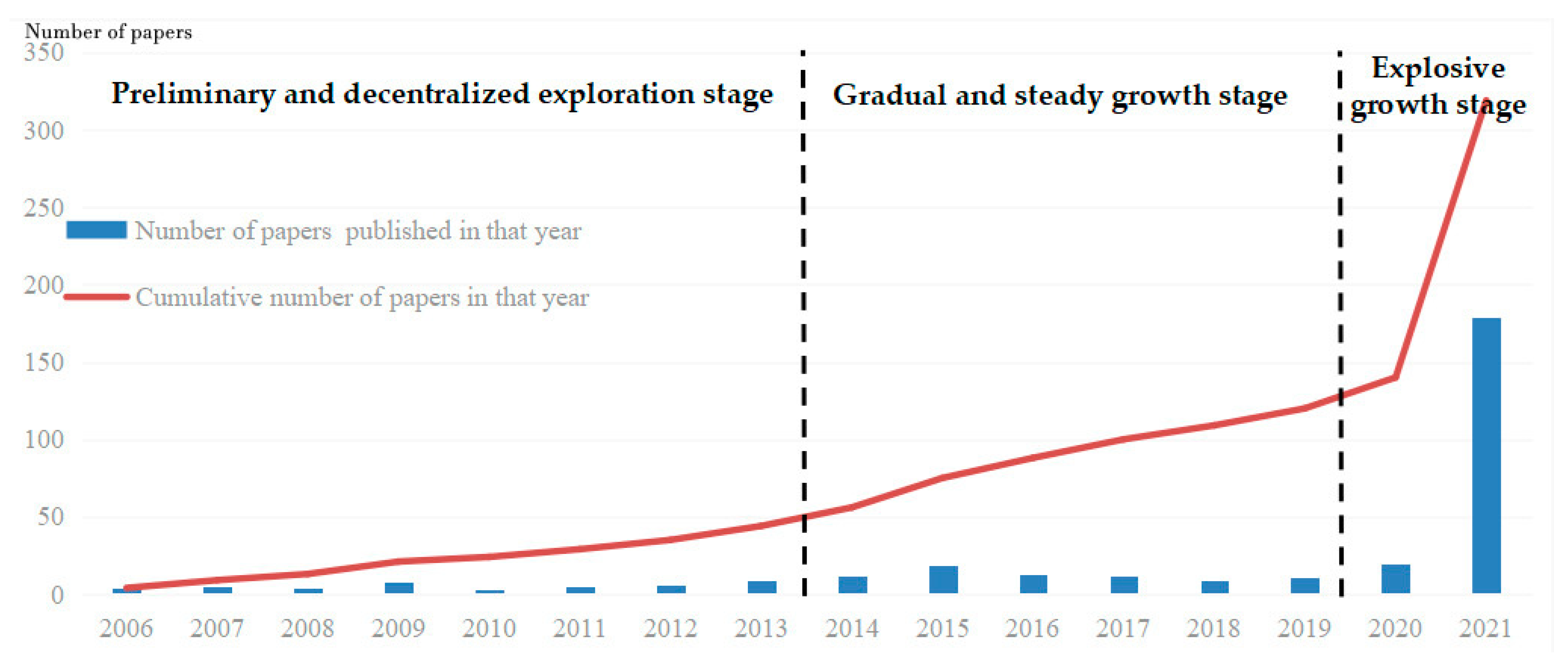
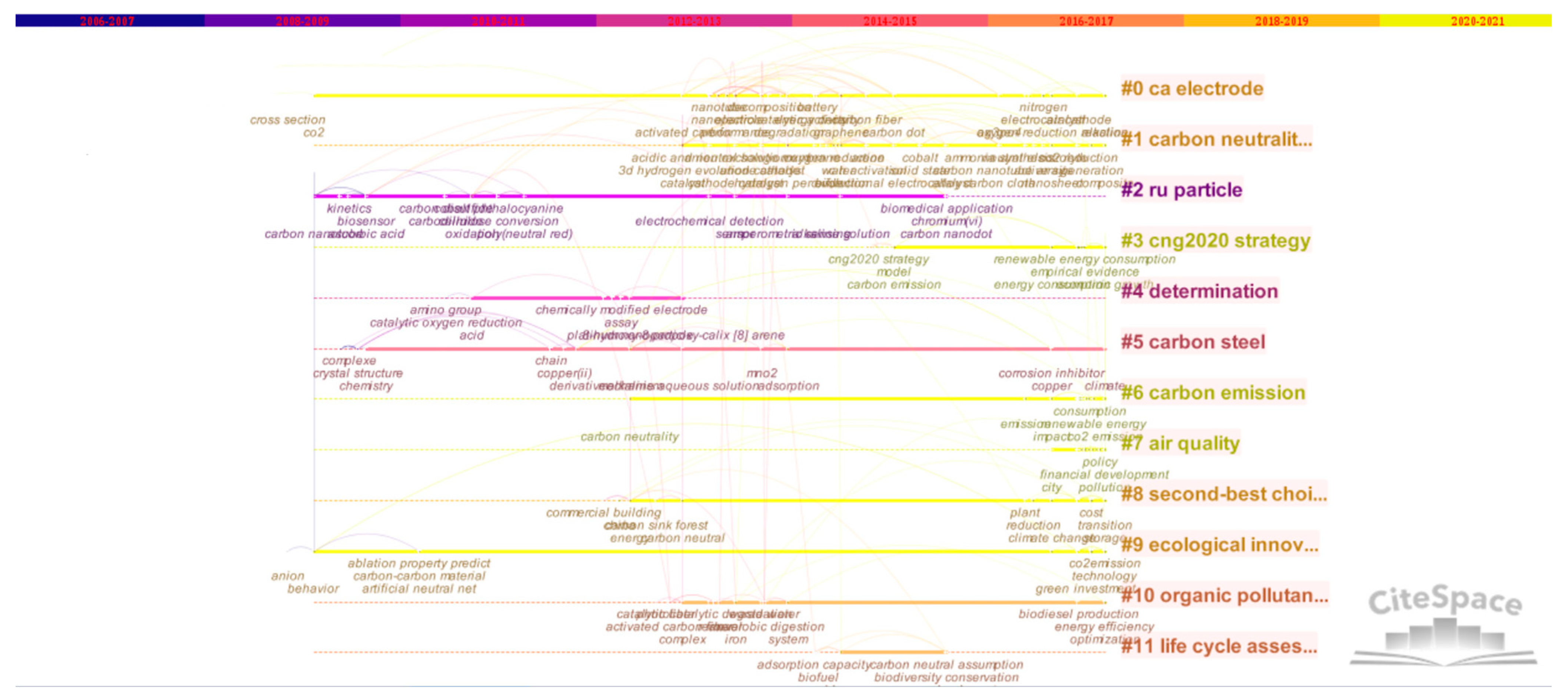

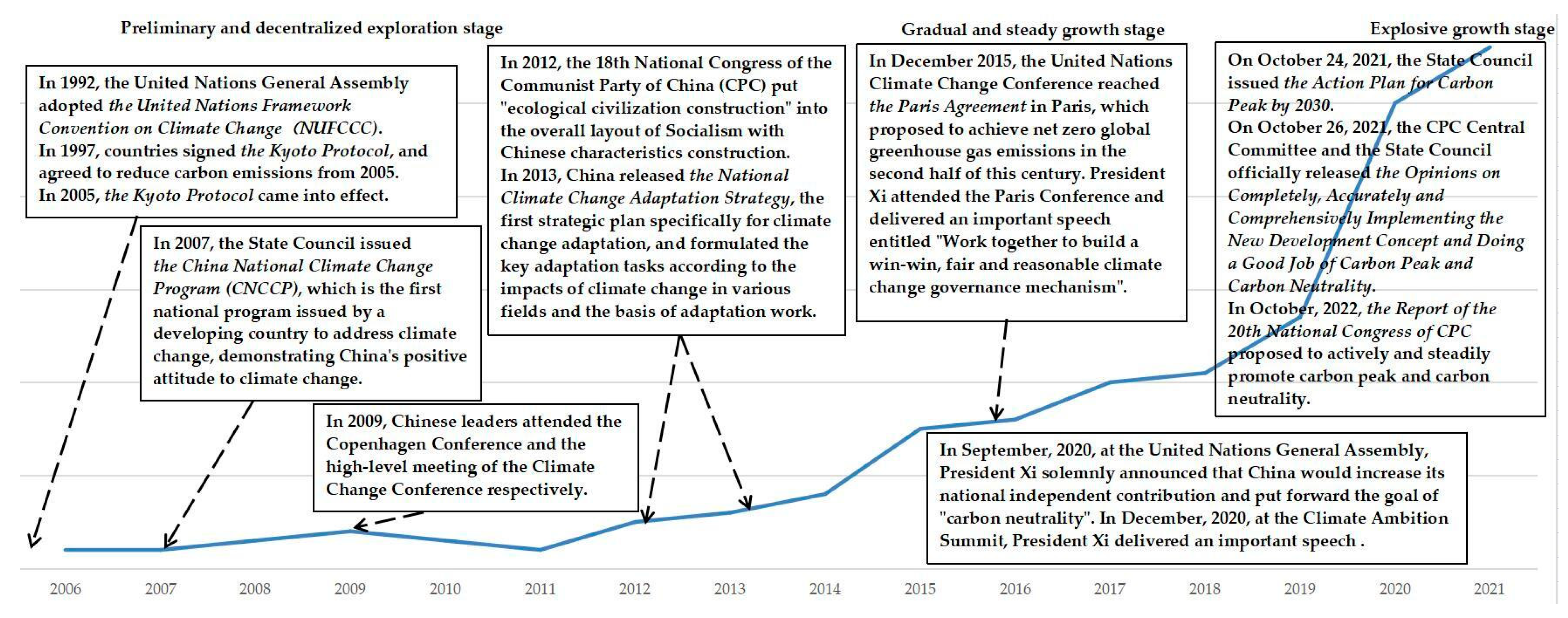
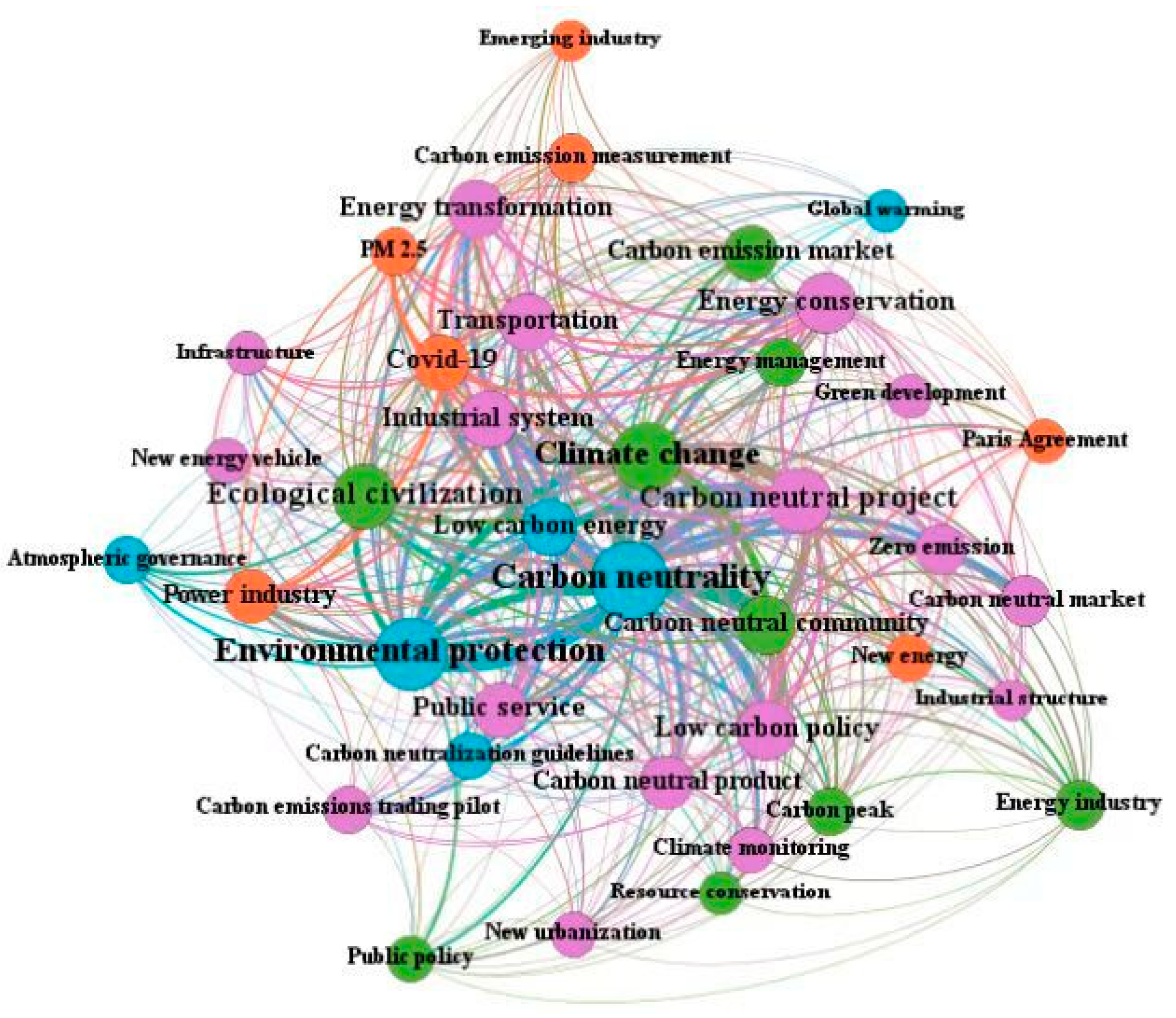
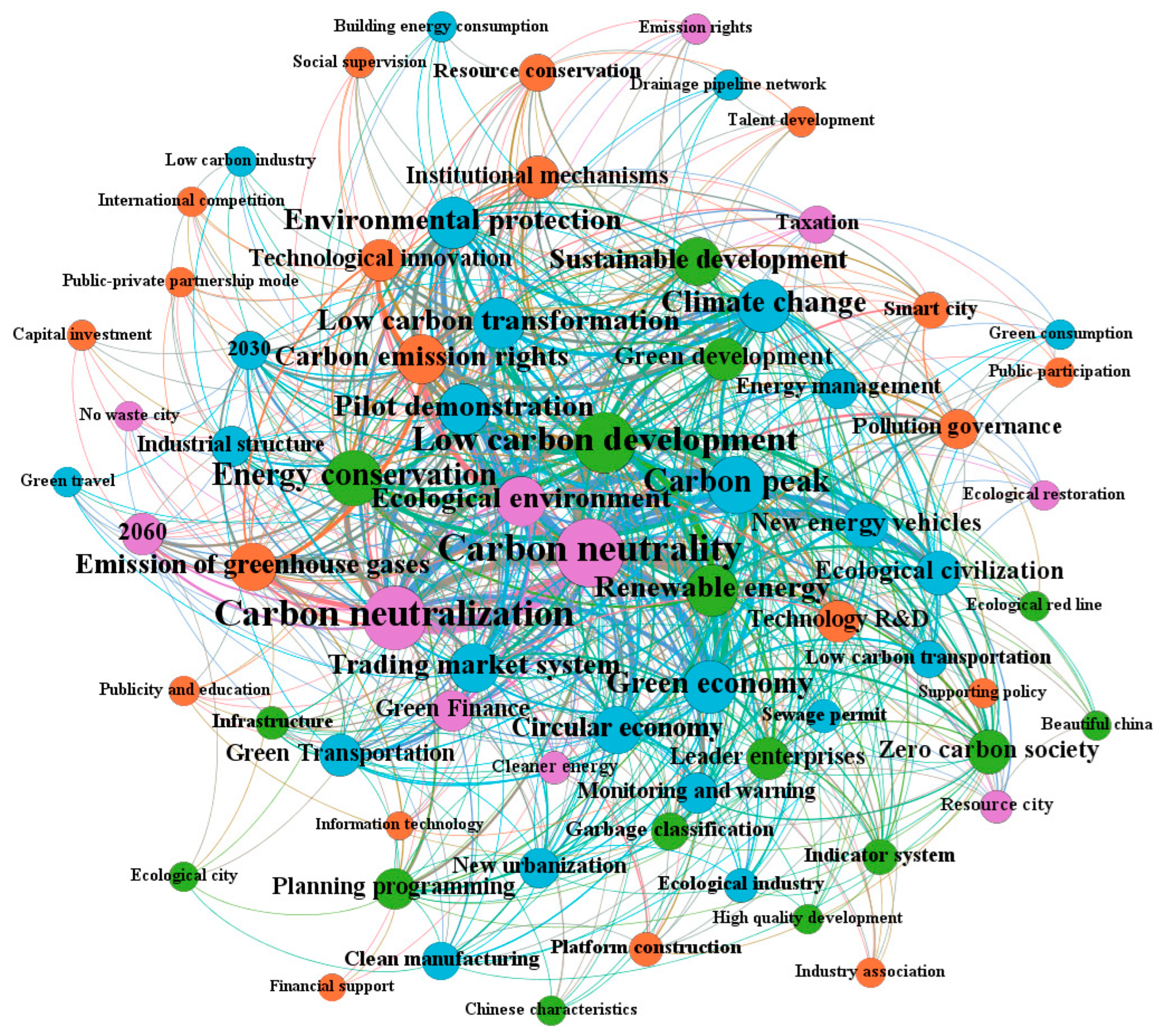
| Goals of Carbon Neutrality | Policy Guarantee | ||
|---|---|---|---|
| Target Year | Country | Status | Country |
| Before 2050 | Bhutan and Suriname (Achieved), Uruguay (2030), Finland(2035), Iceland and Austria (2040), Sweden and Germany (2045), etc. | Legal Level | 13 countries including Sweden, Denmark, France, Hungary, New Zealand, the UK, etc. |
| In Legislation | Fiji, Chile, Spain, Canada, Republic of Korea, etc. | ||
| 2050 | More than 120 countries including the United States, Japan, Canada, New Zealand, Switzerland, Republic of Korea, Norway, etc. (124 of the 137 countries) | Policy Level | More than 120 countries including Norway, Australia, China, Germany, Finland, Iceland, USA, Columbia, etc. |
| 2060 | Australia, Singapore, China, Ukraine, Kazakhstan, etc. | Under Discussion | More than 120 countries including Belgium, Greece, Italy, Maldives, Mexico, etc. |
| No. | Countries/Regions | Paper Numbers |
|---|---|---|
| 1 | USA | 27 |
| 2 | Australia | 15 |
| 3 | Pakistan | 14 |
| 4 | England | 13 |
| 5 | Japan | 12 |
| 6 | Turkey | 12 |
| 7 | France | 9 |
| 8 | Germany | 8 |
| 9 | Canada | 7 |
| 10 | Republic of Korea | 5 |
| No. | Web of Science Categories | Paper Numbers |
|---|---|---|
| 1 | Environmental Sciences | 98 |
| 2 | Energy Fuels | 50 |
| 3 | Physical Chemistry | 39 |
| 4 | Multidisciplinary Materials Science | 34 |
| 5 | Environmental Engineering | 32 |
| 6 | Electrochemistry | 26 |
| 7 | Chemical Engineering | 26 |
| 8 | Green Sustainable Science Technology | 25 |
| 9 | Multidisciplinary Chemistry | 23 |
| 10 | Analytical Chemistry | 22 |
| No. | Institutions (Affiliations) | Paper Numbers |
|---|---|---|
| 1 | Chinese Academy of Science | 48 |
| 2 | University of Chinese Academy of Science (CAS) | 21 |
| 3 | Tsinghua University | 19 |
| 4 | Shandong University | 28 |
| 5 | Xiamen University | 26 |
| 1 | Date | Department | Policy Document |
| Top-Down Design | 24 October 2021 | The Central Committee of CPC, The State Council | Opinions of the Central Committee of CPC and the State Council of China on Completely, Accurately and Comprehensively Implementing the New Development Concept and Doing a Good Job of Carbon Peak and Carbon Neutrality |
| 26 October 2021 | The State Council | Carbon Peak Action Plan by 2030 | |
| N series | Date | Department | Policy Document |
| Green and Low-Carbon Transformation of Energy | 22 March 2022 | National Development and Reform Commission, National Energy Administration | The 14th Five Year Plan for Modern Energy System |
| 23 March 2022 | National Development and Reform Commission, National Energy Administration | Medium and Long-Term Plan for the Development of Hydrogen Energy Industry (2021–2035) | |
| Energy-Saving, Carbon-Reducing, and Efficiency-Increasing Actions | 24 January 2022 | The State Council | Comprehensive Work Plan for Energy Conservation and Emission Reduction in the “14th Five-Year Plan” |
| 3 February 2022 | National Development and Reform Commission, Ministry of Industry and Information Technology, Ministry of Ecology and Environment, National Energy Administration | Implementation Guide for Upgrading Energy Conservation and Carbon Reduction in Key Fields of High Energy Consumption Industries (2022 Edition) | |
| Carbon Peak Action in the Industrial Field | 20 January 2022 | Ministry of Industry and Information Technology, National Development and Reform Commission, Ministry of Ecology and Environment | Guiding Opinions on Promoting High Quality Development of Iron and Steel Industry |
| 11 February 2022 | National Development and Reform Commission | Implementation Guide for Upgrading Energy Conservation and Carbon Reduction in Cement Industry | |
| 28 March 2022 | Ministry of Industry and Information Technology, National Development and Reform Commission, Ministry of Science and Technology, Ministry of Ecology and Environment, Ministry of Emergency Management, National Energy Administration | Guiding Opinions on Promoting the High Quality Development of Petrochemical Industry in the 14th Five-Year Plan | |
| 12 April 2022 | Ministry of Industry and Information Technology, National Development and Reform Commission | Guiding Opinions on High Quality Development of Chemical Fiber Industry | |
| 12 April 2022 | Ministry of Industry and Information Technology, National Development and Reform Commission | Guiding Opinions on High Quality Development of Industrial Textile Industry | |
| Carbon Peak Action in Urban-Rural Construction | 17 November 2021 | Ministry of Agriculture and Rural Affairs | Guiding Opinions on Expanding Multiple Functions of Agriculture and Promoting High Quality Development of Rural Industry |
| 6 January 2022 | Ministry of Housing and Urban-Rural Development | The Action Plan for Promoting the Development of Urban and Rural Construction in the Yangtze River Economic Belt in the “14th Five-Year Plan” | |
| 6 January 2022 | Ministry of Housing and Urban-Rural Development | The Action Plan for Ecological Protection and High quality Development of Urban and Rural Construction in the Yellow River Basin in the “14th Five-Year Plan” | |
| 1 March 2022 | Ministry of Housing and Urban-Rural Development | The 14th Five-Year Plan for Scientific and Technological Development of Housing and Urban Rural Construction | |
| Green and Low Carbon Actions in Transportation | 1 March 2022 | Ministry of Transport, National Railway Administration, Civil Aviation Administration of China, State Post Bureau | Implementation Opinions on Promoting the High Quality Development of Transportation in Central China in the New Era |
| Carbon Reduction Action Supported by Circular Economy | 1 July 2021 | National Development and Reform Commission | The “14th Five-Year Plan” of Circular Economy Development Plan |
| Green and low -carbon technical innovation Green Low Carbon Science and Technology Innovation Action | Unpublished | Green low carbon science and technology innovation action is one of the “Top Ten Actions for Carbon Peak”. Give full play to the supporting and leading role of scientific and technological innovation, improve the system and mechanism of scientific and technological innovation, strengthen innovation capability, and accelerate the green low-carbon scientific and technological revolution. It includes improving the innovation system and mechanism, strengthening the construction of innovation capacity and personnel training, strengthening the basic research of application, and accelerating the research and development, promotion, and application of advanced and applicable technologies. | |
| Consolidation and Improvement of Carbon Sequestration Capacity | 31 December 2021 | National Forestry and Grassland Administration | Guidelines for Validation and Certification of Forestry Carbon Sequestration Projects |
| 21 February 2022 | Ministry of Natural Resources | Economic Value Accounting Method of Marine Carbon Sink | |
| The Green Low Carbon National Action | 7 May 2022 | Ministry of Education | Work Plan for Strengthening the Construction of Higher Education Talent Training System with Carbon Peak and Carbon Neutrality |
| Cascade Orderly Carbon Peak and Carbon Neutrality Actions in Different Regions | The specific implementation policies of each province and city were introduced in the form of strategic guidance documents, safeguard support documents, local laws and regulations, etc. | ||
| Safeguard and Support Policy | 14 December 2021 | China Development Bank | Implementing Green Low Carbon Finance Strategy to Support Carbon Peak and Carbon Neutrality Action Plan |
| 15 March 2022 | Ministry of Ecology and Environment | Accounting Methods and Reporting Guidelines for Greenhouse Vapor Emissions of Enterprises Power Generation Facilities (Revised in 2022) | |
| 30 April 2022 | National Development and Reform Commission | Announcement on Clarifying the Behavior of Operators in the Coal Field to Raise Prices | |
| 18 August 2022 | Ministry of Science and Technology, National Development and Reform Commission, Ministry of Industry and Information Technology, Ministry of Ecology and Environment, Ministry of Housing and Urban-Rural Development, Ministry of Transport, Chinese Academy of Sciences, Chinese Academy of Engineering, National Energy Administration | Implementation Plan for Supporting Carbon Peak and Carbon Neutrality by Science and Technology (2022–2030) | |
Disclaimer/Publisher’s Note: The statements, opinions and data contained in all publications are solely those of the individual author(s) and contributor(s) and not of MDPI and/or the editor(s). MDPI and/or the editor(s) disclaim responsibility for any injury to people or property resulting from any ideas, methods, instructions or products referred to in the content. |
© 2023 by the authors. Licensee MDPI, Basel, Switzerland. This article is an open access article distributed under the terms and conditions of the Creative Commons Attribution (CC BY) license (https://creativecommons.org/licenses/by/4.0/).
Share and Cite
Gao, J.; Zhang, W.; Yang, C.; Wang, Q.; Yuan, R.; Wang, R.; Zhang, L.; Li, Z.; Luo, X. A Comparative Study of China’s Carbon Neutrality Policy and International Research Keywords under the Background of Decarbonization Plans in China. Sustainability 2023, 15, 13069. https://doi.org/10.3390/su151713069
Gao J, Zhang W, Yang C, Wang Q, Yuan R, Wang R, Zhang L, Li Z, Luo X. A Comparative Study of China’s Carbon Neutrality Policy and International Research Keywords under the Background of Decarbonization Plans in China. Sustainability. 2023; 15(17):13069. https://doi.org/10.3390/su151713069
Chicago/Turabian StyleGao, Jie, Wu Zhang, Chunbaixue Yang, Qun Wang, Rui Yuan, Rui Wang, Limiao Zhang, Zhijian Li, and Xiaoli Luo. 2023. "A Comparative Study of China’s Carbon Neutrality Policy and International Research Keywords under the Background of Decarbonization Plans in China" Sustainability 15, no. 17: 13069. https://doi.org/10.3390/su151713069
APA StyleGao, J., Zhang, W., Yang, C., Wang, Q., Yuan, R., Wang, R., Zhang, L., Li, Z., & Luo, X. (2023). A Comparative Study of China’s Carbon Neutrality Policy and International Research Keywords under the Background of Decarbonization Plans in China. Sustainability, 15(17), 13069. https://doi.org/10.3390/su151713069






